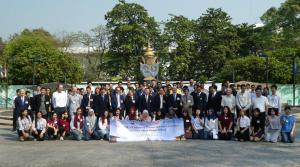Fusion world
A promising newcomer
29 Apr 2019
A small tokamak changed hands in July of last year. HT-6M, a circular limiter machine developed at the Chinese Institute of Plasma Physics (ASIPP) in the 1980s, was pulled out of retirement to start a new life at the Thailand Institute of Nuclear Technology (TINT).
The key to a fusion future: in the presence of Princess Maha Chakri Sirindhorn, B. Wan (director of ASIPP) and B. Lerthirunwong (Chairman of the TINT Board of Directors) proceed with the handing over of the HT-6M tokamak (pictured in the background).
The southeast Asian kingdom, which depends heavily on fossil fuels to cover the electricity needs of its population of 69 million, made its first steps into fusion research in 2015 when a series of conferences was organized in Bangkok by specialists from the French Institute for Magnetic Fusion Research (IRFM).
"The original idea was to expose the younger generation to the challenges and promises of fusion," explains Tuong Hoang, a fusion physicist and international relations expert at IRFM. "Interest was strong and growing, not only in Thailand but also in neighbouring countries like Nepal, the Philippines or Indonesia. At one point, we began discussing with our Chinese colleagues at ASIPP about the possibility of donating HT-6M, as it makes sense to have a tokamak when you are studying magnetic confinement fusion..."
Fusion research in Thailand has a strong proponent in Princess Maha Chakri Sirindhorn, the king's sister, who presided over the handing over of HT-6M in July 2018 and visited ITER a few months later. On the occasion of her visit, a Cooperation Agreement was signed between the ITER Organization and TINT.
Participants to the 4th edition of the ASEAN School on Plasma and Nuclear Fusion (ASPNF) at Mahidol University, Thailand, in January 2019.
IRFM and ASIPP specialists, now joined by Japanese colleagues from the Large Helical Device, are involved in the ASEAN School on Plasma and Nuclear Fusion (ASPNF) they contributed to establishing. "The objective is to train a first nucleus of 20 to 30 physicists and engineers through a five-year program," explains Tuong. "The first class is presently in its second year of training and will soon be ready to practice on HT-6M."



